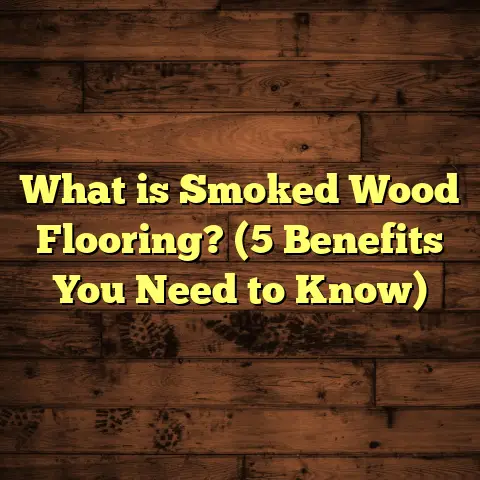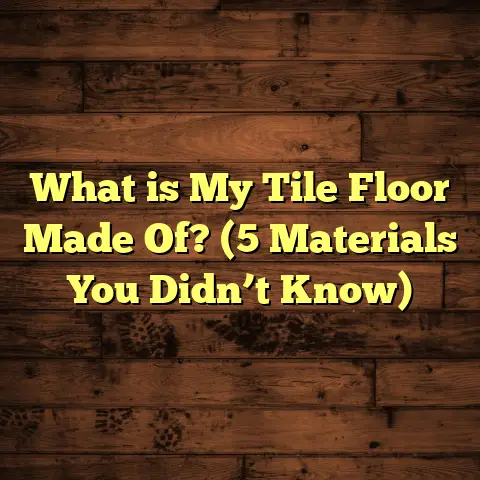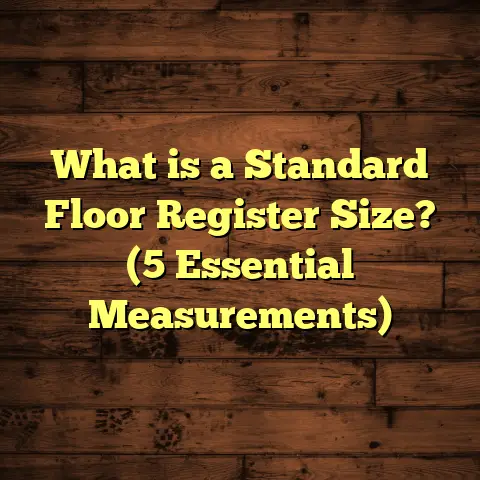What is Peel and Stick Flooring? (5 Essential Tips for DIY)
I remember the frustration of trying to update my floors without spending a fortune or committing to a long, messy renovation. You want something fresh, easy to install, and that looks good—right? That’s exactly why peel and stick flooring caught my attention. If you’re like me, juggling a busy schedule and a limited budget, this flooring option might just be what you need.
What is Peel and Stick Flooring?
Simply put, peel and stick flooring is a type of flooring material that comes with an adhesive backing. You remove the protective layer (the “peel” part), then press it down directly onto your floor surface (the “stick” part). It’s kind of like giant, durable stickers designed for your floors.
These flooring pieces are usually made from vinyl or laminate materials, designed to mimic the look of hardwood, tile, or stone at a fraction of the cost. Because they’re so easy to install without glue or nails, peel and stick tiles or planks have become popular for quick home updates or rental property upgrades.
The vinyl used in these products is typically a composite of several layers: a wear layer on top for durability, a printed design layer for aesthetics, a core layer for stability, and the adhesive backing. The wear layer can be anywhere from 6 mils (thousandths of an inch) to 20 mils thick or more. For perspective, 12-20 mil wear layers offer solid resistance to scratches and dents for residential use.
Why I Chose Peel and Stick Flooring
When I first tried this flooring, I was skeptical. Could something that sticks down like a sticker really hold up in high-traffic areas? The answer surprised me. Over the years, I’ve used peel and stick flooring in my own home’s kitchen, bathroom, and even a small laundry room. Each time, the installation took just a few hours with minimal tools. Plus, the floors looked great and held up well under daily use.
I remember my first project vividly: a tiny bathroom with outdated vinyl that was peeling at the edges. I wanted something affordable but stylish because replacing the whole subfloor or hiring pros was out of the question. After installing peel and stick tiles that mimicked marble, my bathroom felt transformed overnight—and I didn’t have to wait for glue to dry or deal with fumes.
Different Types of Peel and Stick Flooring
Not all peel and stick floors are made equal. Here are the main varieties I’ve worked with:
Vinyl Peel and Stick Tiles
These are the most common. They come in square or rectangular tiles that look like ceramic tile or stone. Vinyl is waterproof and fairly flexible, which helps with installation on uneven surfaces. Vinyl tiles usually have thicknesses ranging from 2mm to 5mm.
Laminate Peel and Stick Planks
Laminate peel and stick planks mimic hardwood floors better than traditional vinyl tiles due to their wood grain patterns. However, they can be less flexible and sometimes require more careful subfloor preparation.
Luxury Vinyl Plank (LVP) Peel and Stick
LVP combines the durability of vinyl with thicker wear layers and more realistic textures. This type is pricier but tends to last longer in high-traffic areas.
Cork Peel and Stick Tiles
Less common but eco-friendly, cork tiles offer natural warmth and soundproofing. They require sealing after installation to protect against moisture.
How to Use Peel and Stick Flooring Effectively
If you want your peel and stick flooring to last, here’s what I’ve learned:
1. Prepare Your Surface Thoroughly
The biggest mistake I see people make is not preparing the floor properly. The adhesive on these tiles or planks needs a smooth, clean surface to bond well.
- Sweep and mop the floor to remove dust, dirt, and grease.
- If your floor is textured or uneven, sand it down or fill gaps with a leveling compound.
- Make sure the surface is dry before starting.
Neglecting this step can cause peeling or bubbles later on.
In one project, I skipped sanding rough patches on a concrete floor thinking it would be fine. Within weeks, several tiles lifted at those spots. Lesson learned: surface prep is everything.
2. Measure Twice, Cut Once
Before peeling off the backing, carefully measure your space. I like to lay out the tiles or planks dry (without removing the adhesive) to get an idea of placement and where I’ll need to cut pieces.
A utility knife works best for cutting these tiles precisely. Take your time here; a clean cut means your floor looks professional and fits tightly.
Sometimes I even mark the back of tiles with pencil lines before cutting, so I’m sure not to make mistakes.
3. Apply Even Pressure During Installation
Once you peel off the backing, press the tile firmly in place. I recommend using a roller or even a rolling pin to apply even pressure across each piece. This helps avoid air bubbles and ensures the adhesive sticks solidly.
Some brands recommend applying pressure for several minutes per tile—don’t rush this.
If you don’t have a roller handy, pressing down firmly with your hands while smoothing from one side to another works well too.
4. Allow Time for Adhesion Before Heavy Use
After installation, let your new floor sit undisturbed for at least 24 hours before moving furniture back or walking heavily on it. This waiting period lets the adhesive cure properly.
In my experience, rushing this step results in loose edges or peeling tiles faster than you’d like.
5. Maintain Your Floor with Gentle Cleaning
One thing I appreciate about peel and stick flooring is its low maintenance. Avoid harsh chemicals or abrasive scrubbing tools that can damage the surface.
A damp mop with mild soap usually does the trick. If a tile gets damaged, you can replace it easily without redoing the entire floor—a huge plus compared to traditional flooring.
Installation: Step-by-Step From My Toolbox
I want to walk you through how I install peel and stick flooring because it’s straightforward but requires some care.
What You’ll Need:
- Measuring tape
- Utility knife
- Straight edge/ruler
- Floor roller or rolling pin
- Leveling compound (optional)
- Cleaning supplies (broom, mop)
- Pencil
Step 1: Clear out your room completely so you can work freely.
Step 2: Clean your floor thoroughly. I sweep then mop with warm water and mild detergent.
Step 3: Check for cracks or bumps. Patch holes or sand down high spots. Use leveling compound if needed — trust me, it makes installation way easier.
Step 4: Lay out your tiles/planks without peeling yet. Plan your pattern carefully starting from the center of the room or along a straight wall for best results.
Step 5: Cut tiles as needed using your utility knife and ruler for straight edges.
Step 6: Start peeling the backing from one corner and stick your tile firmly onto the floor.
Step 7: Press down firmly using your roller or hands to remove air bubbles.
Step 8: Continue row by row until done.
Step 9: Let it cure for at least 24 hours before heavy use.
Comparing Peel and Stick Flooring With Other Options
You might be wondering how peel and stick stacks up against other popular floors like hardwood, laminate (non-adhesive), or traditional vinyl sheets.
| Flooring Type | Cost per Sq Ft | Installation Difficulty | Durability | Maintenance | Visual Appeal |
|---|---|---|---|---|---|
| Peel & Stick Vinyl | $1 – $3 | Easy (DIY) | Moderate | Easy | Good (varies by brand) |
| Hardwood | $8 – $15 | Hard (Pro recommended) | High | Moderate | Excellent |
| Laminate | $2 – $7 | Moderate (DIY possible) | Moderate | Moderate | Good |
| Traditional Vinyl | $2 – $5 | Moderate | Moderate | Easy | Good |
| Tile | $5 – $15 | Hard | Very High | Moderate | Excellent |
Peel and stick flooring shines if you want fast installation without professional help and on a tight budget. Hardwood offers unmatched beauty but costs more upfront plus labor. Laminate is similar but usually needs special underlayment.
How Durable Is Peel and Stick Flooring Really?
I often get asked whether peel and stick floors last long enough to justify their popularity. Based on my experience plus data from manufacturers:
- Most residential-grade peel and stick vinyl tiles last around 5-10 years with proper care.
- Higher-end luxury vinyl planks with thicker wear layers last closer to 10 years.
- Heavy traffic areas may show wear sooner unless you pick commercial-grade options.
- Moisture resistance varies; standard peel and stick vinyl resists spills well but avoid long-term standing water exposure.
One study from a flooring industry group found that when installed correctly on prepared subfloors, peel and stick floors maintained adhesion over 90% of the time after 3 years in residential settings.
Common Problems & How I Fixed Them
Even with easy products like this, issues can pop up:
Peeling Edges
Usually caused by poor surface prep or walking on tiles immediately after install. Fix by lifting edges gently and applying new adhesive if needed.
Air Bubbles
Press firmly during installation; if bubbles form later, puncture them with a needle then press flat again.
Scratches or Dents
Avoid dragging furniture; use pads under legs. Minor scratches can sometimes be buffed out or covered with repair kits sold by manufacturers.
Tiles Not Lining Up Perfectly
This happens if measurements were off or cuts weren’t straight. Take time cutting carefully next time; small gaps can be filled with color-matched caulk for tile products.
Advanced Maintenance Tips From My Experience
Once you have your peel and stick floor installed, keeping it looking fresh requires some basics plus a few extras:
- Sweep daily or vacuum with soft brush attachment.
- Mop weekly using mild soap; avoid ammonia-based cleaners.
- Immediately wipe spills to prevent stains.
- Use furniture pads under heavy items.
- Rotate rugs occasionally so areas don’t fade unevenly.
- Periodically inspect seams for lifting edges.
I once had an accident where paint spilled on my kitchen’s peel and stick floor — quick cleaning with warm soapy water removed it completely without damage.
Unique Insights: Peel and Stick Flooring in Rental Units
I’ve helped several landlords update rental apartments using peel and stick flooring because:
- It’s quick: entire units can be done in a day.
- Affordable: low upfront cost improves property appeal without breaking bank.
- Removable: easy to replace between tenants.
- Durable enough to handle typical tenant wear if installed properly.
One landlord client told me their tenant retention improved after upgrading floors this way compared to old carpet that trapped odors.
Design Trends Using Peel and Stick Floors
If you want your floors to stand out aesthetically:
- Herringbone patterns are trending—easy to create with planks.
- Mixing different tile designs creates interesting mosaic effects.
- Wood-look planks are popular for rustic or farmhouse style.
- Bold colors like navy blue or emerald green vinyl tiles make statement floors in kitchens or bathrooms.
I tried alternating dark gray slate-look tiles with lighter grout lines in my powder room—got rave reviews from visitors!
Are There Eco-Friendly Options?
While most peel and stick floors are synthetic vinyl-based (PVC), some brands now offer low-VOC options that reduce harmful emissions indoors.
Cork-based peel and stick tiles provide natural alternatives but require more care against moisture.
Look for certifications like FloorScore if indoor air quality matters most in your home.
Budgeting Your Peel and Stick Flooring Project
Here’s how I break down costs:
| Item | Estimated Cost |
|---|---|
| Materials | $1 – $3 per sq ft |
| Tools & Supplies | $20 – $50 one-time purchase |
| Floor Prep (optional) | $30 – $100 (patching compound) |
| Total Cost Example (200 sq ft) | $220 – $650 |
Compared to hardwood replacement running into thousands including labor, peel and stick lets you update entire rooms affordably.
My Personal Project Recap: Living Room Refresh
Last fall, tired of scratched hardwood floors in our living room but not ready for full replacement, I tried peel and stick vinyl plank flooring over existing hardwood after light sanding:
- Installation took two afternoons.
- Cost was under $400 total.
- The floor looks modern with subtle wood grain patterns.
- Pets’ claws don’t damage it as easily as real wood.
It’s held up well through winter snow boots too!
FAQs About Peel and Stick Flooring
Q: Can I install peel and stick flooring over carpet?
A: No. Carpet is too soft; floors must be hard surfaces like concrete, wood, or existing vinyl.
Q: Will the adhesive ruin my subfloor when removed?
A: On most smooth surfaces like plywood or concrete, adhesive comes off cleanly. On hardwoods, you may need gentle scraping plus adhesive remover products.
Q: Is it waterproof?
A: Many vinyl options resist water well but standing water can seep through seams if not sealed properly.
Final Thoughts From My Experience
If you want a quick way to transform your floors without breaking the bank or hiring pros, peel and stick flooring is worth considering. It’s budget-friendly, beginner-friendly, and surprisingly durable when installed right.
Have you ever tried peel and stick flooring? What was your experience like? Feel free to ask if you want tips on picking brands or patterns—I’m happy to share what I’ve learned from my projects!





